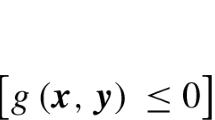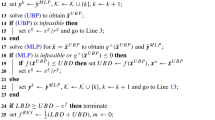Abstract.
Optimization problems involving a finite number of decision variables and an infinite number of constraints are referred to as semi-infinite programs (SIPs). Existing numerical methods for solving nonlinear SIPs make strong assumptions on the properties of the feasible set, e.g., convexity and/or regularity, or solve a discretized approximation which only guarantees a lower bound to the true solution value of the SIP. Here, a general, deterministic algorithm for solving semi-infinite programs to guaranteed global optimality is presented. A branch-and-bound (B&B) framework is used to generate convergent sequences of upper and lower bounds on the SIP solution value. The upper-bounding problem is generated by replacing the infinite number of real-valued constraints with a finite number of constrained inclusion bounds; the lower-bounding problem is formulated as a convex relaxation of a discretized approximation to the SIP. The SIP B&B algorithm is shown to converge finitely to ɛ−optimality when the subdivision and discretization procedures used to formulate the node subproblems are known to retain certain convergence characteristics. Other than the properties assumed by globally-convergent B&B methods (for finitely-constrained NLPs), this SIP algorithm makes only one additional assumption: For every minimizer x* of the SIP there exists a sequence of Slater points xn for which  (cf. Section 5.4). Numerical results for test problems in the SIP literature are presented. The exclusion test and a modified upper-bounding problem are also investigated as heuristic approaches for alleviating the computational cost of solving a nonlinear SIP to guaranteed global optimality.
(cf. Section 5.4). Numerical results for test problems in the SIP literature are presented. The exclusion test and a modified upper-bounding problem are also investigated as heuristic approaches for alleviating the computational cost of solving a nonlinear SIP to guaranteed global optimality.
Similar content being viewed by others
References
Alefeld, G., Mayer, G.: Interval analysis: theory and applications. J. Comput. Appl. Math. 121, 421–464 (2000)
Baumann, E.: Optimal centered forms. BIT 28, 80–87 (1988)
Bhattacharjee, B.: Kinetic Model Reduction using Integer and Semi-Infinite Programming. PhD thesis, Massachusetts Institute of Technology, Cambridge, Massachusetts, December 2003
Bhattacharjee, B., Green, W.H. Jr., Barton, P.I.: Interval methods for semi-infinite programs. Comput. Optim. Appl. 30 (1), 63–94 (2005)
Coope, I.D., Watson, G.A.: Projected Lagrangian algorithm for semi-infinite programming. Math. Program. 32, 337–256 (1985)
Gill, P.E., Murray, W., Saunders, M.A., Wright, M.H.: User’s Guide for NPSOL 5.0: A FORTRAN Package for Nonlinear Programming. 1998
Hettich, R., Kortanek, K.O.: Semi-infinite programming: Theory, methods and applications. SIAM Review 35, 380–429 (1993)
Horst, R.: A general class of branch-and-bound methods in global optimization with some new approaches for concave minimization. J. Optim. Theory Appl. 51, 271–291 (1986)
Horst, R.: Deterministic global optimization with partition sets whose feasibility is not known: Application to concave minimization, reverse convex constraints, DC-programming,and Lipschitzian optimization. J. Optim. Theory Appl. 58, 11–37 (1988)
Horst, R., Tuy, H.: Global Optimization: Deterministic approaches. Springer-Verlag, 1996. 3rd Edition
McCormick, G.P.: Computability of global solutions to factorable nonconvex programs: Part I: Convex underestimating problems. Math. Program. 10, 147–175 (1976)
Moore, R.: Methods and Applications of Interval Analysis. SIAM, Philadelphia PA, 1979
Polak, E.: Optimization Algorithms and Consistent Approximations. Springer-Verlag, New York, New York, 1997
Ratschek, H., Rokne, J.: Computer Methods for the Range of Functions. Ellis Horwood Limited, Chichester, England, 1984
Reemsten, R., Gorner, S.: Numerical methods for semi-infinite programming: A survey. In: R. Reemsten, J. Ruckmann (eds.), Semi-infinite Programming, Kluwer Academic Publishers, Dordrecht, Netherlands, 1998, pp. 195–275
Singer, A.B.: LibBandB.a Version 3.1 Manual. Massachusetts Institute of Technology, Cambridge, MA, 2003
Singer, A.B., Barton, P.I.: Global Solution of Optimization Problems with Parameter-Embedded Linear Dynamic Systems. J. Optim. Theory Appl. 121 (3), 613–646 (2004)
Stein, O.: Bi-level Strategies in Semi-infinite Programming. Kluwer, 2003
Still, G.: Generalized semi-infinite programming: Theory and Methods. European J. Oper. Res. 119, 303–313 (1999)
Author information
Authors and Affiliations
Corresponding author
Rights and permissions
About this article
Cite this article
Bhattacharjee, B., Lemonidis, P., Green Jr., W. et al. Global solution of semi-infinite programs. Math. Program. 103, 283–307 (2005). https://doi.org/10.1007/s10107-005-0583-6
Received:
Accepted:
Published:
Issue Date:
DOI: https://doi.org/10.1007/s10107-005-0583-6




